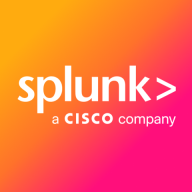

Splunk Cloud Platform and Splunk Enterprise Platform compete in the enterprise IT solutions category. Splunk Cloud Platform seems to have the upper hand with its cloud-native advantages and operational efficiency.
Features: Splunk Cloud Platform offers rapid deployment, enhanced flexibility in log handling, and robust enterprise security features. Its indexing and business controls provide significant value, and it alleviates infrastructure management needs by eliminating on-premises setups. Splunk Enterprise Platform's customizable solutions excel in IT monitoring, security, and observability, providing superior analytics and detailed local support for extensive on-premises requirements.
Ease of Deployment and Customer Service: Splunk Cloud Platform offers straightforward deployment in public and hybrid cloud environments but faces challenges with support responsiveness, despite some customer service improvements. In contrast, Splunk Enterprise Platform requires more manual setup for on-premises environments yet benefits from established technical support, although the quality varies, offering detailed consultation for enterprise users.
Pricing and ROI: Splunk Cloud Platform is perceived as expensive due to ingest-based licensing costs, impacting data integration. However, users find value in its advanced features and business resilience, achieving ROI from improved metric tracking and environmental monitoring. Splunk Enterprise Platform also incurs high costs but offers slightly more flexible pricing options. Its robust features correlate with high costs, suitable for larger enterprises, with users reporting ROI due to visibility and efficient data management.
Splunk Cloud Platform has impacted operational costs; it's a bit expensive, but it provides value for money.
Splunk Enterprise Platform saves approximately 20 to 30 percent of my time without having to perform different actions separately.
Premium support is costly and may not always provide a satisfactory experience.
It is crucial for anyone looking to deploy Splunk Enterprise Platform to first certify for their courses, such as the Splunk Administrator and the Power User Administrator certifications, which address all troubleshooting queries.
If the server is down, I can upgrade the server resources or create a new node for performance optimization.
Some products can automatically scale, but Splunk requires manual configuration changes to achieve scale, which is slightly outdated compared to modern technologies.
Splunk Enterprise Platform is scalable to some extent, which is acceptable.
Splunk Enterprise Platform is stable when not integrating or adding new devices continuously.
It requires managing configuration files and processing operations manually, limiting its auto-scaling capabilities.
Integration is a bit difficult due to the coding required for the integrations.
Splunk Cloud Platform needs improvement in its security offerings, specifically in cybersecurity.
The deep learning capabilities need enhancing, especially on Splunk Cloud, where customers find it challenging to use deep learning tools without setting up backend computing resources.
The cost is the most significant area for improvement in Splunk Enterprise Platform, as it is quite expensive, causing many clients to differ due to this reason.
It is complex for inexperienced cybersecurity engineers and requires experienced personnel to handle it effectively.
Splunk Cloud is considered too expensive, with its two product offerings both being costly.
If I were to rate the price for the product from 1 to 10, I would rate it nine.
The pricing model is based on ingesting data sizes, not user count, and includes a free tier for up to 500 MB of daily data.
Splunk Enterprise Platform is expensive.
The most valuable feature of Splunk Cloud Platform is its robustness and ability to ingest logs.
The real-time search capability of this product enhances operational decision-making.
Splunk Enterprise Platform also has its own Phantom as a SOAR, which is much more refined and gives more accurate results than any other AI integrated SIM tool.
The features that have proven most effective for real-time data analysis include parts of the platform and its automation capabilities.
One valuable feature of Splunk Enterprise Platform is citizen programming, which allows users to manage and compute huge stream-based datasets easily using SPL language.
| Product | Market Share (%) |
|---|---|
| Splunk Cloud Platform | 1.2% |
| Splunk Enterprise Platform | 1.6% |
| Other | 97.2% |


| Company Size | Count |
|---|---|
| Small Business | 11 |
| Midsize Enterprise | 6 |
| Large Enterprise | 42 |
| Company Size | Count |
|---|---|
| Small Business | 11 |
| Midsize Enterprise | 1 |
| Large Enterprise | 23 |
Splunk Cloud Platform enhances operational efficiency with streamlined log management and real-time data analysis, offering customizable dashboards, seamless system integration, and a user-friendly interface that simplifies infrastructure management.
Splunk Cloud Platform stands out for its robust indexing and powerful search capabilities, delivering end-to-end visibility across environments. AI-driven security measures enhance cybersecurity intelligence, while its flexible log management reduces resolution times. The platform integrates effortlessly with diverse systems, supporting centralized log management, security monitoring, and application performance analysis. Users leverage its comprehensive analytics for troubleshooting, alerting, and visualization, optimizing costs and ensuring compliance with unified data sources.
What are the key features of Splunk Cloud Platform?In many industries, Splunk Cloud Platform is implemented primarily for unified log management, cybersecurity initiatives, and application performance monitoring. Businesses utilize it to streamline IT operations, integrate data sources, and leverage insights for troubleshooting and strategic decision-making, ensuring compliance and optimized resource use.
Explore data of any type and value — no matter where it lives in your data ecosystem.
Drive business resilience by monitoring, alerting and reporting on your operations.
Create custom dashboards and data visualizations to unlock insights from anywhere — in your operations center, on the desktop, in the field and on the go.
Use data from anywhere across your entire organization so you can make meaningful decisions fast.
We monitor all Data Visualization reviews to prevent fraudulent reviews and keep review quality high. We do not post reviews by company employees or direct competitors. We validate each review for authenticity via cross-reference with LinkedIn, and personal follow-up with the reviewer when necessary.